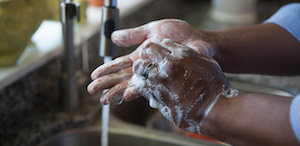Washing Hands Prevents Illness & Spread of Infection to Others
November 4, 2024

According to the Center for Disease Control & Prevention many diseases and conditions are spread by not washing hands with soap and clean, running water. CDC recommends cleaning hands in a specific way to avoid getting sick and spreading germs to others. The recommendations for effective handwashing and use of hand sanitizer was developed based on data from a number of studies. Learn more about how to wash your hands and why clean hands help keep you healthy.
Washing hands prevents illnesses and spread of infections to others.
- People frequently touch their eyes, nose, and mouth without even realizing it. Germs can get into the body through the eyes, nose and mouth and make us sick.
- Germs from unwashed hands can get into foods and drinks while people prepare or consume them. Germs can multiply in some types of foods or drinks, under certain conditions, and make people sick.
- Germs from unwashed hands can be transferred to other objects, like handrails, tabletops, or toys, and then transferred to another person's hands.
How to clean your hands
With an alcohol-based hand sanitizer:
- Put product on hands and rub together.
- Cover all surfaces until hands feel dry.
- This should take around 20 seconds.
With Soap and water:
- We your hands with warm water. Use liquid soap If possible. Apply a nickel or quarter size amount of soap on your hands.
- Rub your hands together until the soap forms a lather and then rub all over the top of your hands, in between your fingers and the area around and under your finger nails.
- Continue rubbing your hands for at least 15 seconds. Need a timer? Imagine singing “Happy Birthday” song twice.
- Rinse your hands well under running water.
- Dry your hands using paper towel if possible. Then use your paper towel to turn off the faucet and to open the door if needed.